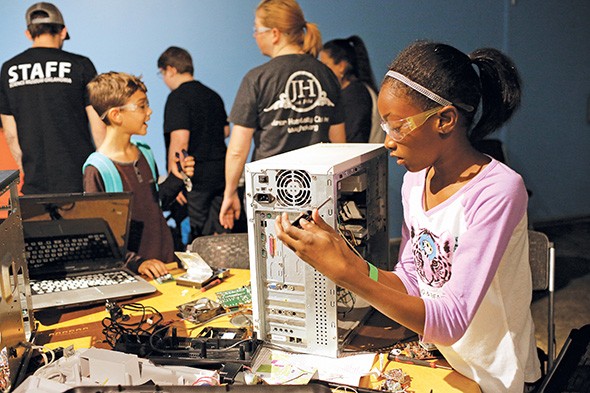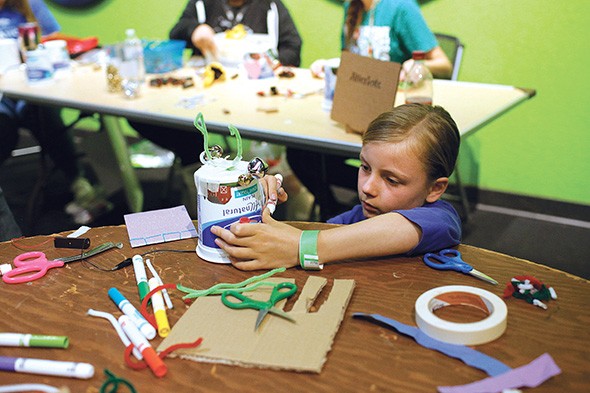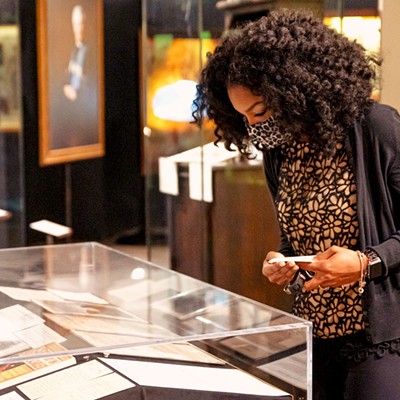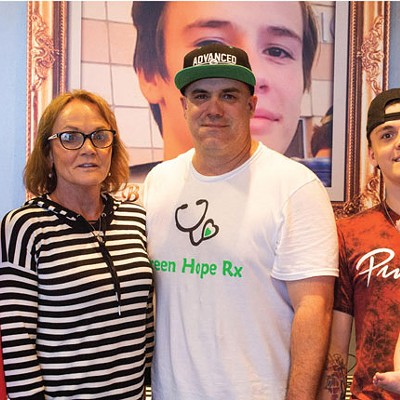
Walking through Science Museum Oklahoma (SMO) with a child with Asperger’s Syndrome is a different experience, a much more cautious experience. Thousands of people are bouncing around the exhibits like hyper-heated particles in a boiling cauldron of water, lights and sounds and explosions abound and children with sensory sensitivities retreat into protective shells. Overwhelmed with stimuli and unwilling to battle through the hordes, these children lose out on exhibits that might, in a calmer setting, captivate them.
This has been an ongoing concern for SMO, and early childhood educator Candace Barrios is helping the museum make the experience more welcoming to children with various sensory development disorders through a special evening event called Tinker ’Bout It. With smaller crowds, lights dimmed and fewer surprise explosions, Tinker ’Bout It is form-fitted for children who find it hard to cope with SMO at its busiest, brightest and loudest.
“There is just so much going on, so much sound, so much to touch that sometimes even I come into the museum and say, ‘Whoa,’” Barrios said. “Tinker ’Bout It is for families with a child that has been diagnosed with a sensory processing disorder, is autistic or has any developmental delays that have to do with their senses. We are doing some minor adjustments to the museum to make it friendlier to them by just toning everything down.”
Vice president of programming Clint Stone added that the event is also for patrons who might not be diagnosed with a specific condition but know they need a quieter, less intense experience to be able to fully enjoy SMO.
“There will not be thousands of people at the museum because this is meant to be a quieter event that we are limiting to a couple hundred,” Stone said. “We will have the full engaging experience we usually have, everything you would expect to see and try for the first time, then be awed by it. But the pace is what we are intentionally changing, making it a little slower, taking the time to let people know what’s about to happen, including quieting certain areas, brightening some areas, bringing down the bright lights at other areas.”
Otto, the SMO mascot, will also be taking the night off, just to ensure there are no distractions between the patrons and the exhibits. Barrios said there will be zip lines, a petting zoo with bunnies and an alpaca, squishy circuits, candle making, an automata lab to learn to assemble things with moving parts, a phenakistoscope that uses an early form of animation to allow attendees to make their own cartoons and foil boat-making at the water table in the Wunderground. Barrios’ favorite feature of Tinker ’Bout It is the oobleck sensory table, playing with the non-Newtonian fluid named after a similar goop in a Dr. Seuss book. A list of activities for the night is available on the SMO website.
Sensory kit
Barrios has helped develop a special kit made available on a first-come, first-served basis for patrons with sensory needs. They’ll be available the night of Tinker ’Bout It, but also whenever the museum is open.
“In the kit, we have a set of noise-canceling headphones, so if they do come to the museum during a normal operating day and do want to go to Science Live, this will help with the noise,” Barrios said. “There are digital timers that are helpful for parents that have children where they need to be like, ‘Okay, we have five minutes, then we need to move on.’ We also have the old-fashioned crank timers with the ding. We have sunglasses for the bright areas of the museum, fidget toys, gloves for tactile purposes.”

There will also be booklets that go into the various exhibits, available in the kit and downloadable on the SMO website. They break down what children can expect to experience and what sensory issues they might encounter. SMO will also be placing facilitators throughout the museum to keep the exhibits a bit more orderly.
“Our Big Game Theory, for instance, will usually have a lot of kids out there, playing with games and building materials, and they will decide on their own how to share and how they want to be involved,” Stone said. “On a typical day, we can have a lot of kids in there running, playing, knocking things down. It can be a noisy place. On this night, we will have a facilitator helping everyone work together. It’ll be a lot quieter than it usually is in Big Game Theory.”
Tinker ’Bout It is part of an ongoing effort to find ways to make SMO as approachable as possible to the community with more specialized events to come. Part of the importance, according to Barrios, is that kids retreating into their protective shells because of sensory overload might also be gifted in STEM (science, technology, engineering and math) subjects because of that same ability to take in information with a unique intensity. What makes some uncomfortable in crowds can also make them brilliant in specialized fields.
In his book, Awkward: The Science of Why We’re Socially Awkward and Why That’s Awesome, Ty Tashiro explains that social awkwardness can come from a tendency to witness the world with a spotlight rather than taking in a social scene as a whole. This intense focus means that swimming through the chaos of a packed and energetic museum can be difficult, if not crippling. But seeing the world through a spotlight rather than a floodlight allows for an opportunity for deeper perception into science, technology, math and art.
Temple Grandin has also written extensively in books such as Thinking in Pictures and Other Reports from My Life with Autism about her struggles with and triumphs because of autism. Barrios believes it is critical to make SMO accessible to children on the spectrum because those same children might be the ones unlocking the mysteries of the universe that will become future SMO exhibits.
“We are excited about this direction and hope to continue focusing on STEM and STEAM [science, technology, engineering, art and math] at these events because we know that autistic children can excel,” Barrios said.
“And this is the purpose of our museum, to reveal the wonder and relevance of science,” Stone added. “All these people come to us, we don’t know what their future holds or how their futures will change our futures. If this event can reach one guest and be that spark, then we’ve reached our goal. Granted, we won’t know that for 20 or 30 years, but we have to approach every day with that goal.”
Visit sciencemuseumok.org.










